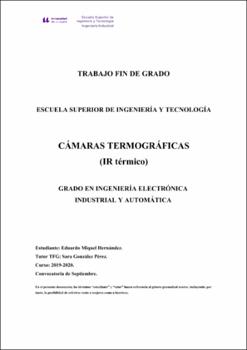Cámaras termográficas (IR térmico)
Fecha
2020Resumen
En este trabajo se presentan, en primer lugar, los contenidos teóricos necesarios para
entender el funcionamiento de las cámaras termográficas, así como su correcta utilización
en la instalación de las mismas en centros e instituciones públicas o privadas como las
facultades y centros de la Universidad de La Laguna con el objetivo de detectar estados
febriles en los alumnos, profesores y trabajadores de estas instituciones.
Además, se realiza una comparativa de los dispositivos e instrumentos encontrados en el
mercado termográfico, junto a sus prestaciones y su adaptabilidad y viabilidad para el
objetivo propuesto. Seguidamente, se enumeran las diferentes aplicaciones de estos
dispositivos, tanto a nivel industrial como ambiental, y se enuncia también la normativa
aplicable que regula esta actividad y en la que se debe basar en la detección de fiebre.
A continuación, se presenta una investigación concreta realizada utilizando una cámara
térmica de la marca Thermal Expert, concretamente el modelo TE-V1, mediante la cual
se ha hecho un estudio infrarrojo del ambiente y de mí mismo, obteniendo una serie de
resultados analizados con un software específico para la cámara infrarroja.
Y, por último, las conclusiones del trabajo, en las que se aclara las limitaciones de las
cámaras térmicas, la importancia de la calibración, con un cuerpo negro a ser posible,
para obtener temperaturas razonables y los valores que se deben ajustar según las
condiciones del lugar y sus alrededores. First of all, this work shows the theoretical content necessary to understand
thermographic cameras performance, as well as their correct usefulness about their
installation in public or private institutions like the faculties or facilities of the University
of La Laguna with the aim of detecting feverish states of the students, teachers and
employees of the institution.
In addition, it is made a comparison between the devices and instruments found in the
thermographic market, with their skills and their adaptability and viability of
incorporation at the entrance of the faculties. Next, the different applications of these
devices are listed, including industrial and environmental level, and it’s also stated the
applicable regulations that regulate this activity and on which it should be based on the
detection of fever.
Then, is displayed a concrete investigation carried out using a thermal camera from the
Thermal Expert brand, specifically the TE-V1 model, through which an infrared study of
the environment and myself has been made, obtaining a series of results analysed with a
specific software for the infrared camera.
And, finally, the conclusions of the work, in which the limitations of thermal cameras are
clarified, and also the importance of calibration, if possible with a black body, to obtain
reasonable temperatures and the values that must be adjusted according to the conditions
of the place and its surroundings.





